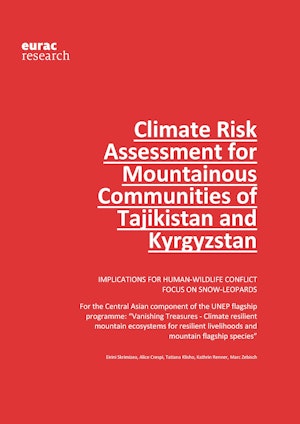Climate risk assessment for mountainous communities of Tajikistan and Kyrgyzstan. Implications for human-wildlife conflict focus on snow-leopards
UNEP’s ‘Vanishing Treasures’ Programme supports climate change adaptation of vulnerable species in mountain regions such as in Hindu-Kush Himalayas (Bhutan), in Central Asia (Kyrgyzstan and Tajikistan) and in Virunga region (Rwanda and Uganda). The Programme is funded by the Grand Duchy of Luxembourg and aims to generate maximum synergy between climate change adaptation and biodiversity conservation by improving the adaptive capacity of mountain ecosystems while maintaining related ecosystem services, protecting mountain flagship species who are key to ecosystem functioning, and promoting alternative livelihoods for local communities. Eurac Research has been the contractor and responsible for the climate risk analysis in Central Asia under the technical supervision of UNEP and the programme advisors, and in close cooperation with designated implementing partners. Eurac Research supports the implementation of the ‘Snow Leopard in Central Asia’ component of the Programme through the elaboration of future climate scenarios and climate risk assessments in selected project regions and communities of Tajikistan and Kyrgyzstan. This report presents the approach, methodological steps, and findings of the climate risk assessments for the Tajikistan and Kyrgyzstan project regions and communities under the ‘Vanishing Treasures Programme’. Climate risk assessment is a crucial analytical step to understand and structure the climate risk and its underlying causes to eventually prepare, identify and select climate change adaptation actions. The climate risk assessments presented in this report have been developed with a community-centred focus and with the two main objectives of i) promoting sustainable land-use and livelihoods under climate change conditions, while considering ‘external’ socio-economic drivers, and ii) minimizing conflicts between Snow Leopard conservation and communities’ livelihoods in the context of climate change. The communities under study are mountainous communities relying on livelihoods of mixed crop-livestock mountain agriculture, with a focus on livestock breeding for subsistence in Tajikistan, and market-oriented livestock breeding in Kyrgyzstan. Current human-wildlife interactions in the two areas, including the interaction with the snow leopard, refer primarily to livestock depredation by wild carnivores; pasture sharing between livestock and wildlife that constitutes snow leopard prey; and poaching.
Access work
https://works.eurac.edu/Report-vanishing-treasures-2023-bear.pdf
This content is licensed under a Creative Commons Attribution 4.0 International license except for third-party materials or where otherwise noted.

